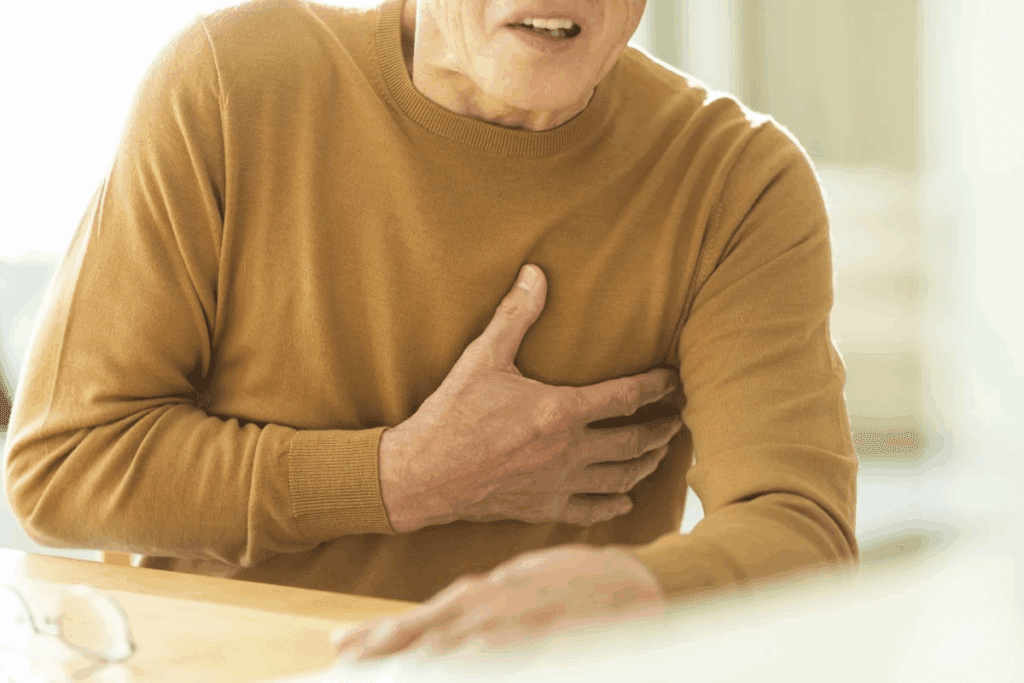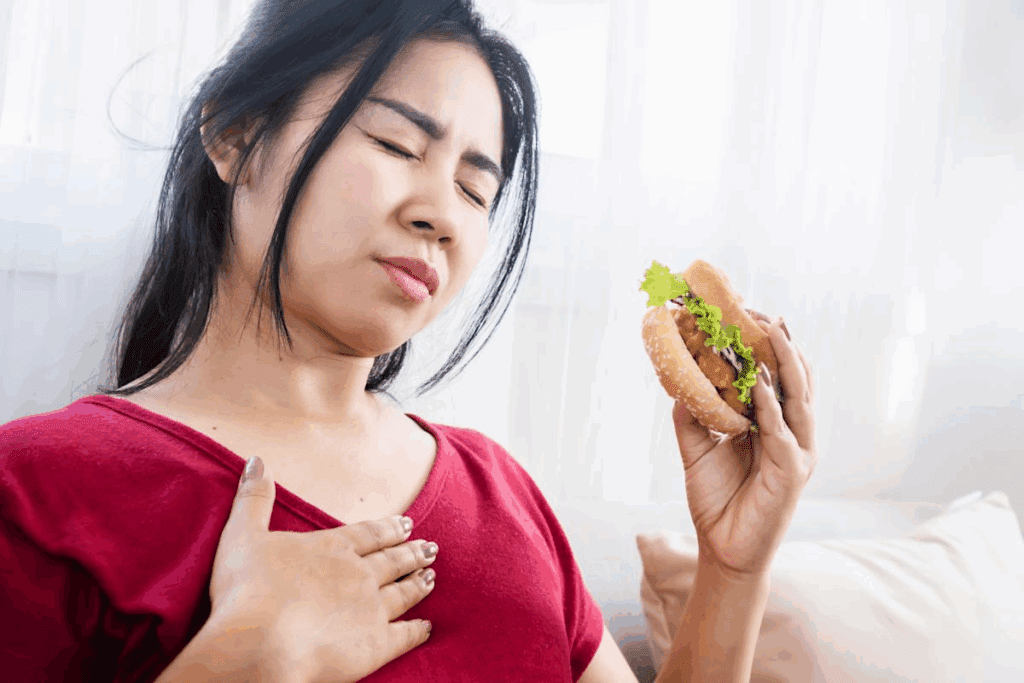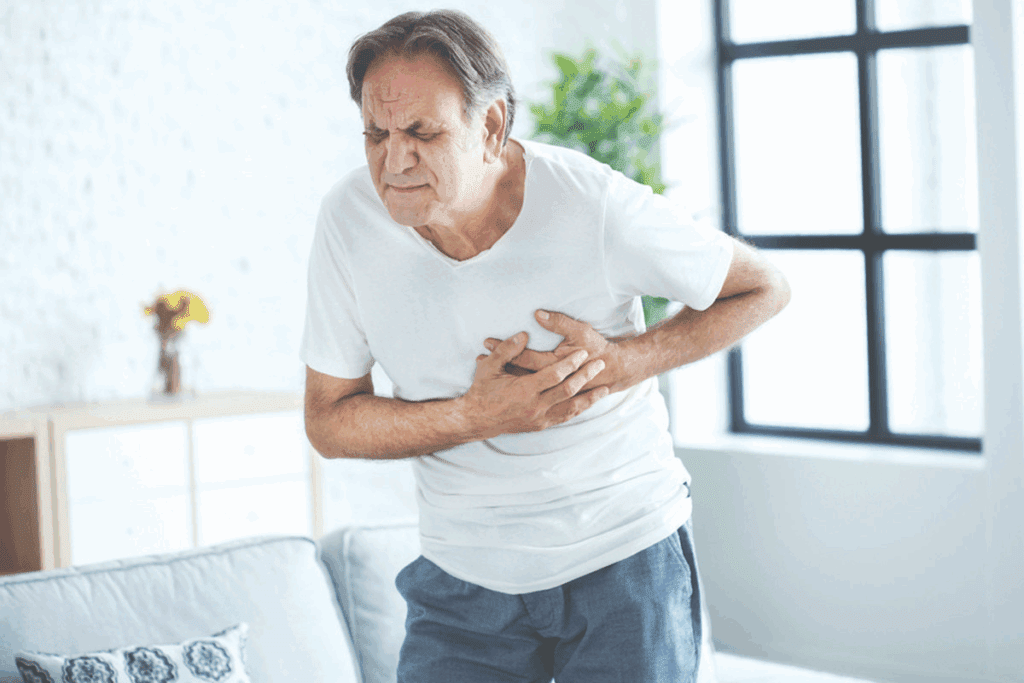Last Updated on October 31, 2025 by Batuhan Temel

Feeling chest tightness or pain after eating can be scary, and it happens a lot. At Liv Hospital, we know how important it is to fix these symptoms fast.
Chest tightness after eating is often linked to digestive issues like GERD, eating too much, or gobbling food too fast. Knowing why it happens is key to feeling better.
We’ll show you how to ease chest discomfort after meals step by step. By figuring out the root cause and making small changes, you can ease these uncomfortable feelings.
Learn how do I stop chest tightness after eating with proven relief strategies.

Feeling chest tightness after meals can be scary. It’s important to know why it happens to find relief. This symptom can show up in many ways, making people worry about their health.
People feel chest tightness in different ways. Some feel a burning sensation, while others feel pressure or discomfort. These feelings can come and go, sometimes with other stomach problems like bloating or nausea.
Knowing what you feel is the first step to figuring out why. For example, a burning feeling might mean you have acid reflux. This is when stomach acid goes back up into your esophagus, causing pain.
It’s important to tell if chest tightness comes from your stomach or heart. Both can hurt, but they mean different things.
Heart pain is serious and can feel like pressure or squeezing in your chest. It might also spread to your arms or jaw. Digestive pain, on the other hand, usually comes from your stomach or esophagus. Things like gastroesophageal reflux disease (GERD) or spasms can make your chest feel tight after eating.
To figure out where the pain is coming from, think about when it happens and what triggers it. If it happens right after you eat and you also feel other stomach problems, it might be from your stomach. But if it happens during exercise or with symptoms like dizziness or trouble breathing, it could be heart-related and needs urgent care.

Many people experience chest pain after eating. It’s important to know why this happens. We’ll look at the main reasons, like health issues and how we eat.
GERD happens when stomach acid goes back up into the esophagus. This can cause a burning feeling in the chest, known as heartburn. GERD is a common cause of chest pain after eating, often when lying down or after big or fatty meals.
To manage GERD symptoms, try lifestyle changes and sometimes medication. Avoid foods that trigger it, eat smaller meals, and don’t lie down after eating.
Eating too much or too fast can cause chest pain. Overeating puts pressure on the stomach, pushing against the diaphragm. This can lead to chest pain. Eating fast can also cause swallowing air, leading to bloating and discomfort.
These tips can help avoid chest pain after eating.
Gas and bloating can also cause chest pain after eating. When the body can’t digest certain foods, it builds up gas. This makes the stomach expand, putting pressure on the diaphragm and causing pain.
Foods like beans, cabbage, and broccoli can cause gas. Avoiding these foods or taking digestive enzymes can help manage gas and bloating.
Knowing why we get chest pain after eating helps us prevent and manage it. We can change our diet, eating habits, or seek medical help for conditions like GERD. There are many ways to ease chest pain after eating.
When you feel chest pain on the left side after eating, it’s important to know why. This pain could be from your stomach or your heart. Finding out the cause is key to feeling better.
Esophageal spasms are when your esophagus contracts too much, causing pain. They can happen for many reasons, like eating hot or cold foods, feeling stressed, or taking certain medicines. Knowing what causes these spasms helps manage the pain.
Some common things that can trigger esophageal spasms include:
It’s important to tell if your chest pain is from your stomach or your heart. Esophageal spasms are a stomach problem, but heart issues like angina or a heart attack can also cause pain. If the pain is bad, lasts a long time, or comes with other scary symptoms, get help right away.
Doctors will do tests like ECGs, endoscopies, and imaging to figure out why you’re feeling pain. Knowing the cause helps them find the right treatment for you.
Here are some tips for dealing with left side chest pain after eating:
Feeling chest pain on the right side after eating can be scary. It’s important to find out why it happens. Knowing the possible reasons can help fix the problem.
The gallbladder helps break down fats in our food. When we eat fatty foods, it releases bile. But, gallstones or inflammation can stop this process, causing pain.
Gallbladder issues are a common reason for right side chest pain after eating fatty foods. The pain can feel like a dull ache or a sharp stab. Sometimes, you might also feel nauseous or want to vomit.
The liver is also important and can cause right side chest pain after eating. Even though the liver doesn’t have pain receptors, swelling or inflammation can cause discomfort. This is because the tissues around it stretch.
Liver-related discomfort after meals can be due to fatty liver disease or hepatitis. These conditions can get worse with certain foods, leading to pain on the right side of the chest.
It’s key to understand why you have right side chest pain after eating. Knowing if it’s from the gallbladder or liver can help you find relief and prevent it from happening again.
Chest tightness after eating is common and can be fixed with simple steps. It’s important to know how to quickly ease the discomfort.
Keeping the right posture after meals can help with chest tightness. Sit up straight or stand instead of lying down. This stops stomach acid from going back up.
“Sitting upright after meals can make a big difference in reducing discomfort,” a gastroenterology specialist notes. Also, avoid bending or stooping to prevent extra pressure on your stomach.
Deep breathing can calm your body and ease chest tightness. Start by inhaling slowly through your nose, hold for a few seconds, and then exhale slowly through your mouth. Do this a few times.
As you breathe, try to relax your muscles and let go of tension. Deep breathing is a strong way to handle chest tightness.
OTC remedies can quickly help with chest tightness from acid reflux or indigestion. Antacids like Tums or Rolaids neutralize stomach acid. Acid reducers, like ranitidine, lower acid production.
Always read the label and talk to a doctor if you’re unsure. Choosing the right OTC medication is key for your symptoms.
By using these quick relief strategies, you can manage chest tightness after eating. This will make you feel more comfortable every day.
Feeling tightness in your chest after eating can be scary. But, there are ways to handle it. We’ll show you how to ease this discomfort step by step.
When you feel tightness in your chest after eating, stay calm. Getting upset can make it worse. Try sitting up or standing to breathe better and ease pressure on your chest.
Don’t lie down, as it can make symptoms worse.
For quick relief, try over-the-counter antacids. They can help with heartburn and chest tightness. Also, loosen tight clothes around your waist and chest to feel better.
These simple steps can give you quick relief and help you manage the discomfort.
To manage chest tightness, find out what triggers it. Keep a food diary to track what you eat and any symptoms that follow. This can show you patterns and foods that cause trouble.
Knowing your triggers lets you change your diet and habits to avoid future tightness.
Knowing how food affects your body is key to lessening chest pain after meals. Some foods can make symptoms worse, while others can help. By choosing the right foods, we can cut down on chest pain.
Some foods can cause chest pain in many people. These include:
Adding certain foods to your diet can help ease chest pain. These include:
When and how much we eat is just as important as what we eat. Meal timing and portion control are key strategies:
By making these dietary changes, we can greatly reduce chest pain after eating. It’s about making smart food choices and being aware of how they affect our bodies.
By making sustainable lifestyle changes, we can lower the risk of chest discomfort. These changes can greatly improve our health and happiness.
Keeping a healthy weight is key to avoiding chest tightness after eating. Too much weight can put extra pressure on the stomach. This can cause stomach acid to flow back up and cause discomfort.
We suggest a balanced diet and regular exercise to keep a healthy weight. This can help a lot.
Some good ways to manage weight include:
Stress can make chest tightness worse. It’s important to find ways to reduce stress every day. Activities like meditation, deep breathing, and yoga can help.
Some effective ways to reduce stress include:
Good sleep is essential for health, and bad sleep habits can increase stress and discomfort. A consistent sleep schedule and a sleep-friendly environment can improve sleep quality.
Here are some tips for better sleep:
By making these lifestyle changes, we can greatly reduce chest tightness after eating. And we can also improve our overall well-being.
Many people are looking for natural ways to ease chest tightness after meals. We’ll see how these options can help with digestion and comfort.
Herbal teas are known for their digestive benefits. Ginger tea has anti-inflammatory properties that soothe the stomach. Peppermint tea relaxes stomach muscles and boosts digestion, reducing chest tightness.
Chamomile tea calms the digestive system. Licorice root tea protects the stomach lining. Drinking these teas after meals can help with digestion and prevent discomfort.
Probiotics are good bacteria that keep the gut healthy. They help digest food, reducing bloating and gas that can cause chest tightness. Adding probiotic-rich foods like yogurt or supplements can improve gut health.
Digestive enzymes break down food into smaller nutrients. This reduces digestive strain. They’re great for those who feel uncomfortable after eating due to enzyme issues.
Using these natural remedies and supplements daily can help reduce chest tightness after meals. It can also improve overall digestive health.
Knowing when to get medical help for chest tightness after eating can save lives. Sometimes, you can handle mild discomfort with lifestyle changes and over-the-counter remedies. But, there are times when you need to see a doctor right away.
It’s key to know the warning signs that mean you need to see a doctor fast. These include:
If you’re feeling any of these symptoms, don’t wait to get medical help. Your health is very important, and quick action can make a big difference.
When you go to the doctor for chest tightness after eating, they might suggest some tests. These tests help find out what’s causing your symptoms. They can include:
These tests help your doctor figure out why you’re feeling chest tightness. Then, they can plan the best treatment for you.
Knowing when to get medical help and what tests are available can help you take care of your health. If you’re worried about your symptoms, don’t hesitate to talk to a doctor.
Medical treatments are key in managing chest tightness after eating. If symptoms don’t go away, it’s important to look into different treatments. These can help ease symptoms and improve life quality.
Prescription medications are often needed to manage chest tightness. They can help lessen symptoms and treat underlying issues.
These medicines can greatly help manage symptoms. But, it’s important to listen to your doctor about how to use them.
In some cases, specialized treatments are needed for chest tightness. This is because of underlying conditions.
Working closely with a healthcare provider is key to finding the right treatment for persistent chest tightness.
Understanding why chest tightness happens after eating is key. By knowing the causes, we can find ways to feel better. We looked at how GERD, eating too much, and gas and bloating can cause discomfort.
There are many ways to ease chest tightness. Quick fixes like good posture and breathing help. Also, changing what we eat and how we live can make a big difference.
It’s important to know when to see a doctor. If symptoms don’t go away, it’s time to get help. By following these tips, we can manage chest tightness and feel better overall.
Chest pain after eating can be caused by many things. This includes Gastroesophageal Reflux Disease (GERD), overeating, or eating too fast. It can also be due to gas and bloating or other health issues.
Digestive pain is linked to eating and might include bloating or discomfort. Cardiac pain, on the other hand, is related to heart problems. It can be triggered by physical activity or stress.
Overeating can put pressure on your stomach. This can cause stomach acid to flow back up into your esophagus, leading to chest tightness. Eating too fast can also cause discomfort by swallowing air.
Yes, gallbladder issues like gallstones or inflammation can cause pain on the right side of your chest. This pain is often worse after eating fatty foods.
You can relieve chest tightness by maintaining good posture and practicing breathing techniques. Over-the-counter remedies like antacids or acid reducers can also help.
To prevent chest pain, avoid trigger foods like spicy or fatty foods. Eat smaller portions and include beneficial foods like oatmeal or bananas in your diet.
Yes, stress reduction techniques like meditation or deep breathing can help manage stress. This can help alleviate chest pain.
Seek medical attention if you have severe or persistent pain, trouble swallowing, or other concerning symptoms. It’s important to act quickly.
Your doctor might suggest tests like endoscopy or imaging studies. These tests can help find the cause of your chest pain.
Yes, making healthy lifestyle choices can help prevent chest pain. This includes maintaining a healthy weight, reducing stress, and getting enough sleep.
Yes, natural remedies like ginger tea or peppermint tea can soothe your digestive system. Probiotics and digestive enzymes can also help reduce symptoms.
For persistent chest tightness, your doctor might prescribe medications like proton pump inhibitors or antacids. Specialized treatments for conditions like GERD or gallbladder disease can also be helpful.
Chest pain after eating can be a sign of an underlying condition, like GERD or esophageal spasms. It’s important to see a healthcare professional to find out why.
Yes, eating too quickly can lead to swallowing air. This can cause discomfort and chest pain.
To stop chest tightness, understand the causes, make dietary changes, and practice relaxation techniques. These steps can help alleviate symptoms.
National Health Service (NHS). (2025). How to Stop Chest Tightness After Eating StepbyStep. Retrieved from https://www.nhs.uk/conditions/indigestion-and-heartburn/
Subscribe to our e-newsletter to stay informed about the latest innovations in the world of health and exclusive offers!
WhatsApp us